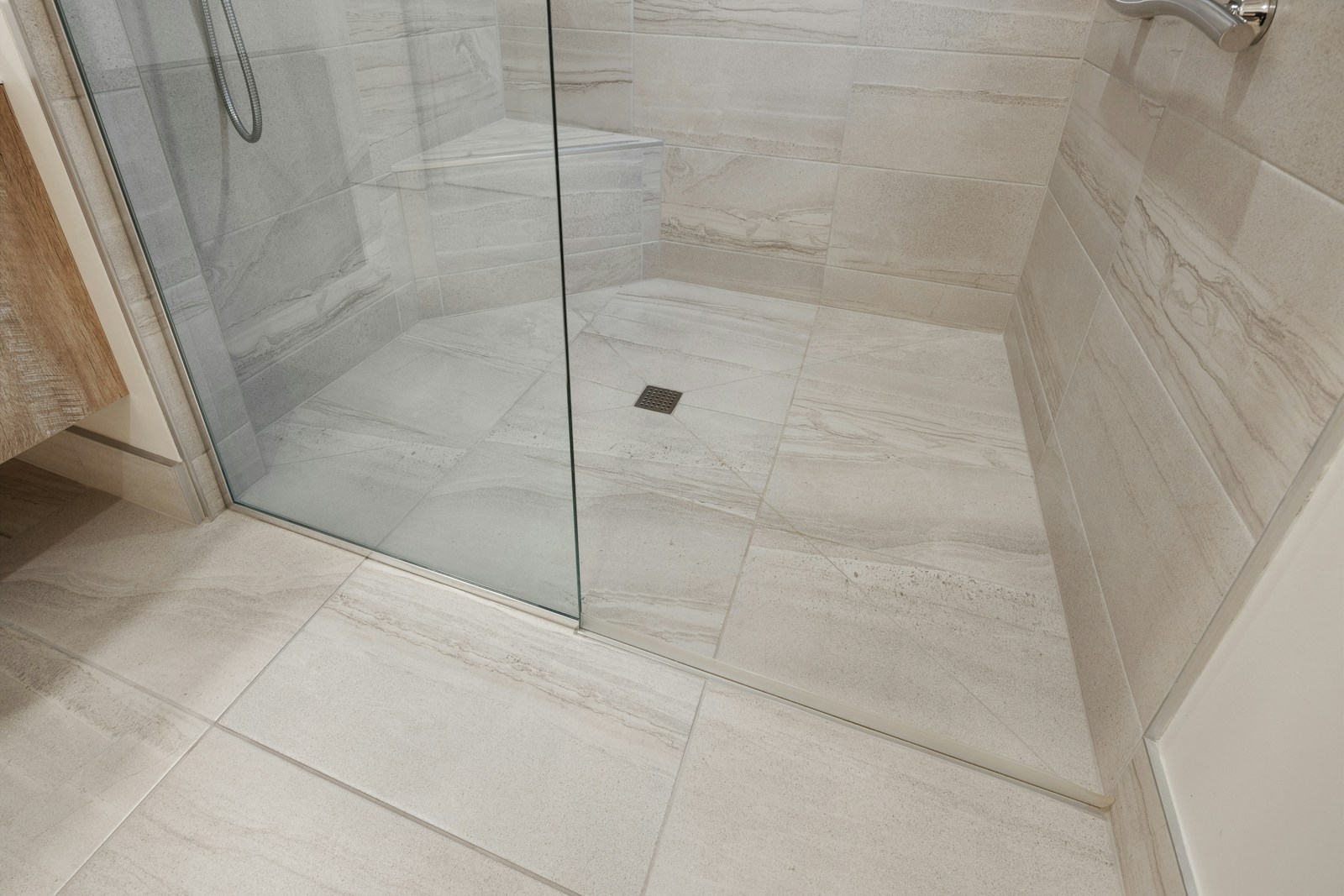Floor drains may not be the most glamorous feature, but they are an essential part of many spaces, from commercial kitchens to residential basements. Whether you’re considering installing floor drains, upgrading an existing system, or just curious about the types available, this guide will walk you through everything you need to know.

“M Resort Room – Shower Drain” by Miss Shari is licensed under CC BY-NC-ND 2.0
Floor Drains vs. Other Drains
When considering the type of drain to install, it’s essential to understand the key differences between floor drains and other types of drains, such as sink drains, shower drains, and storm drains. Each serves a distinct purpose and has unique design features that cater to specific needs.
1. Placement and Purpose
Floor Drains: Typically found in basements, garages, laundry rooms, and commercial spaces, floor drains are installed flush with the floor to collect water runoff, spills, and overflow. Their primary purpose is to prevent flooding and maintain a dry, safe environment.
Other Drains: Sink and shower drains are designed to handle water from fixtures such as faucets and showers, whereas storm drains are placed outdoors to manage rainwater and prevent flooding in streets and public areas.
2. Design and Capacity
Floor Drains: Floor drains are generally larger in diameter compared to sink or shower drains, allowing them to handle large volumes of water at once. They are also equipped with grates or covers to filter out debris and avoid blockages.
Other Drains: While sink and shower drains are smaller and suited for controlled flows of wastewater, storm drains are designed for high-capacity rainwater management, often with wider openings and sloped surfaces for enhanced drainage efficiency.
3. Maintenance Requirements
Floor Drains: Routine maintenance is crucial to keep floor drains clear of debris and functioning well. Traps are typically integrated to prevent foul odors and sewer gases from entering indoor spaces.
Other Drains: Sink and shower drains often require frequent cleaning to remove hair, soap scum, and other buildup, while storm drains need clearing of leaves and outdoor debris to ensure proper drainage.
4. Materials and Durability
Floor Drains: Commonly made from durable materials like cast iron or stainless steel, floor drains are built to withstand heavy foot traffic and extreme conditions, making them ideal for commercial and industrial use.
Other Drains: Sink and shower drains feature materials such as plastic or lighter metals, as they face less strain. Storm drains, on the other hand, are often constructed with concrete or heavy-duty steel to endure outdoor environments.
5. Installation Specifics
Floor Drains: These require thoughtful installation to ensure proper sloping of the surrounding floor and alignment with plumbing systems. They also often include waterproofing layers to prevent leaks into underlying structures.
Other Drains: Sink and shower drain installation is more straightforward and typically confined to connecting to existing plumbing from fixtures, whereas storm drains involve larger-scale outdoor excavation and sloping.
By understanding these distinctions, you can better choose the appropriate drain type for your space and ensure optimal performance for its intended use. Whether managing interior spills or outdoor rainwater, the type of drain selected plays a critical role in efficiency and longevity.

“floor drain” by Leo Reynolds is licensed under CC BY-NC-SA 2.0
Why Floor Drains Are Essential
Floor drains are vital for efficiently managing liquids in any space. Designed to collect and direct excess water, grease, or other liquids into an underground drainage system, they prevent flooding, structural damage, and hazardous conditions caused by pooling. Beyond functionality, a well-installed floor drain enhances hygiene and prolongs the lifespan of your flooring.
When considering floor drains, it’s crucial to think of both performance and durability. Cast iron, a frequently used material, is a common choice for its strength and long-lasting properties. If paired with nickel bronze finishes, these drains can also add a touch of polish while resisting wear and corrosion.

Photo by Tima Miroshnichenko on Pexels
Main Types of Floor Drains
Choosing the right type of floor drain depends on the space it will serve. Here’s a breakdown of the most common types:
General Purpose Floor Drains
Found in spaces like laundries, basements, parking garages, and washrooms, general-purpose floor drains are perfect for locations with regular water use. They’re designed to handle moderate liquid flow, making them a great all-round option.
- Material Options: Cast iron is most common, adding durability and corrosion resistance.
- Features: Available with filters to block debris and prevent clogs.
Trench Drains
Trench drains are long, narrow drains ideal for handling large volumes of water over wide spaces. You’ll often see these in commercial kitchens, loading docks, and outdoor settings like driveways.
- Design Benefits: They are highly efficient for areas where water needs to flow out quickly.
- Material Options: Cast iron for durability, often paired with stainless steel or nickel bronze grates for additional strength and aesthetic value.
Point Drains
Typically used where all liquids need to flow toward a single collection point, these are common in showers, locker rooms, and tight residential spaces. Point drains come in various designs, from classic to modern, making them versatile for both functional and decorative purposes.
Specialty Drains
Some spaces, such as labs, hospitals, and commercial food preparation areas, require specialty floor drains. These are designed with unique features, such as grease interceptors or chemical-resistant coatings, to deal with specific substances safely and efficiently.
Benefits of Using Cast Iron and Nickel Bronze
When choosing a floor drain, materials matter. Cast iron and nickel bronze are popular choices because they bring both practicality and style.
- Cast Iron:
- Extremely durable, capable of handling heavy-load areas like commercial kitchens and parking garages.
- Highly resistant to wear and tear, ensuring a long service life.
- Highly resistant to wear and tear, ensuring a long service life.
- Nickel Bronze:
- Ideal for spaces where aesthetics are important, offering a sleek, modern look.
- Provides excellent resistance to corrosion, even in spaces with high moisture levels.
- Provides excellent resistance to corrosion, even in spaces with high moisture levels.
Together, cast iron and nickel bronze result in floor drains that are not only functional but also complement the space they’re in.
Steps to Install Floor Drains
Proper installation of floor drains ensures that they work efficiently and last for years. Here’s a quick step-by-step guide:
- Choose the Right Type of Drain: Decide on the type (e.g., point drain, trench drain) based on your space requirements and expected volume of water or liquid.
- Consider Material and Design: Select durable materials like cast iron and finishes like nickel bronze to match your needs for strength and style.
- Check Local Plumbing Codes: Ensure that the installation complies with local standards to avoid future issues and ensure proper water drainage.
- Prepare the Site: Mark where the drain will be installed, taking care to ensure proper slope toward the drain location for optimal water flow.
- Install Filters or Grates: Add grates or filters for easy maintenance, preventing clogs caused by debris or grease buildup.
- Test the Drain: After installation, run water through the system to check for leaks or uneven flow and ensure everything functions as expected.
Why Hiring Professional Plumbers Like Those At GAEPlumbing&Heating Is the Safer Option
While some drain installations may seem manageable with a DIY approach, hiring a professional plumber, like those at G.A. Eberly Plumbing & Heating, offers a safer and more reliable solution. Professional plumbers are equipped with the knowledge, tools, and experience to handle complex plumbing tasks efficiently and effectively, reducing the risk of errors or damage. Attempting plumbing work without the proper expertise can lead to leaks, blockages, or even severe water damage, resulting in costly repairs down the line.
With G.A. Eberly Plumbing & Heating, you can trust that the job will be done correctly the first time. Their team ensures that your drains are installed according to local codes and standards, providing peace of mind and long-lasting results. Additionally, professional plumbers can identify underlying issues and recommend solutions that might be overlooked in a DIY project. By leaving the work to trusted professionals, you invest in the safety and longevity of your plumbing system while avoiding unnecessary stress and potential hazards.

Photo by Ellie Burgin on Pexels
Maintenance Tips to Check Your Drain’s Health
Regular maintenance is key to ensuring that floor drains remain efficient. Here’s how you can check and maintain your drains:
- Clean Filters Regularly: Remove and clean filters to prevent clogs and maintain smooth drainage.
- Inspect for Debris: Check for and clear out leaves, grease, and other debris that might accumulate, particularly in drains exposed to frequent use or the outdoors.
- Snake the Drain: If you notice slow drainage, use a plumbing snake to clear out any blockages.
- Flush the System: Periodically flush the system with clean water to remove any residue.
Top Considerations When Choosing Floor Drains
Here are a few important factors to remember when selecting your floor drains:
- Space and Application: Think about the liquids you need to drain, whether it’s water, grease, or hazardous chemicals.
- Material: Cast iron is ideal for strength, while nickel bronze offers both functionality and an attractive finish.
- Ease of Maintenance: Designs with removable grates or filters make it easier to clean and maintain your floor drains over time.
- Stock Availability: Many suppliers carry floor drains in stock. Always ensure the supplier you choose offers products with high-quality materials for your application.
Helpful Resources on Floor Drains
Here are 7 valuable resources to learn more about floor drains, installation tips, and maintenance:
- The Family Handyman – 6 Types Of Basement Floor Drains: A step-by-step guide on how to install a floor drain, including necessary tools and safety tips.
- Bob Vila – Basement Floor Drains: Advice on keeping your floor/basement drain clean and functioning properly to prevent clogs and backups.
- This Old House – Plumbing Guide: A thorough explanation of how floor drains work and essential maintenance tips.
- EPA – Proper Drainage Systems: Learn how proper drainage systems fit into overall home water management to avoid issues like flooding.
- Home Depot – Floor Drains Buying Guide: A comprehensive guide to selecting floor drains based on your project requirements.
- PlumbingSupply.com – Floor Drains and Covers: An online resource offering details about different types of floor drains and their components.
- InspectAPedia – Floor Drain Odor: A troubleshooting guide that identifies common issues with floor drains and how to fix them.
These trusted resources provide useful insights whether you’re installing, maintaining, or troubleshooting a floor drain in your home or commercial property.
Elevate Your Space With the Right Product
Floor drains might not always be visible, but their importance cannot be understated. A well-designed floor drain, constructed from durable materials like cast iron or featuring attractive nickel bronze finishes, can add functionality and even elevate the look of your space.
From installation to maintenance, the right choice ensures your floor drain does its job effectively while enhancing safety and hygiene. With so many types available, you’re sure to find the ideal option for your requirements.

